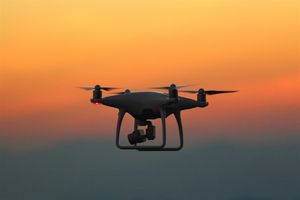
The Uttar Pradesh International Trade Show (UPITS-2025), held from September 25th to September 29th, 2025, in Greater Noida, has successfully concluded, marking a significant stride in the integration of technology into public safety and governance. The third edition of this multi-sector trade fair, inaugurated by Prime Minister Narendra Modi, served as a powerful platform to showcase Uttar Pradesh's growing prowess in manufacturing, crafts, agriculture, and crucially, technology. Beyond its immediate goal of boosting exports and fostering industrial growth, UPITS-2025 highlighted the state's ambitious vision for a tech-driven future, particularly in enhancing security and streamlining administrative processes.
The immediate implications of UPITS-2025 are profound for the technology sector, especially for companies specializing in artificial intelligence, surveillance systems, and digital infrastructure. The event demonstrated a clear governmental commitment to leveraging advanced technologies for public good, from live AI model demonstrations by the IT and Electronics Department to the practical application of AI in managing large-scale events like Mahakumbh. This signals a burgeoning market for tech solutions providers and a potential shift in how public services and safety protocols are conceptualized and implemented across the state and potentially the nation.
A Deep Dive into Tech-Driven Public Safety
The recent UPITS-2025 was not merely a trade show but a vibrant exhibition of Uttar Pradesh's commitment to integrating cutting-edge technology into the fabric of public safety and governance. Held at the India Expo Centre & Mart in Greater Noida, the event, which ran from September 25th to September 29th, 2025, captivated over 500,000 visitors, offering a glimpse into the future of smart policing. The UP Police department, a major highlight in Hall 4, showcased an impressive array of high-tech initiatives. This included a sophisticated Cyber Help Desk, educating the public on digital arrests and fraud prevention, alongside practical tools like the U-Feed machine for extracting data from criminal devices. Traffic and vigilance technologies such as camera-equipped breathalyzers, speed radar guns, body-worn cameras, and mobile data terminals demonstrated the state's proactive approach to accident prevention and law enforcement. Furthermore, the Anti-Terrorist Squad (ATS) and Special Task Force (STF) presented advanced weaponry, including a DRDO-made rocket launcher and a firefighting robot, underscoring the formidable capabilities of the state's security apparatus.
The timeline of UPITS-2025 was packed with significant engagements. Following its inauguration by Prime Minister Narendra Modi on September 25th, the subsequent days featured knowledge sessions on crucial topics like startups, IT and electronics, and healthcare. A pivotal moment occurred on September 27th with the Global Capability Centres (GCCs) conclave, hosted by Invest UP in collaboration with Dun & Bradstreet India. This conclave brought together global tech leaders and policymakers, including representatives from companies like (ADBE) Adobe, (CAP) Capgemini, and (IT) Interra IT, to discuss Uttar Pradesh's burgeoning technology and innovation ecosystem. The event concluded on September 29th with an award ceremony, celebrating the contributions of entrepreneurs, exporters, and innovators, with the UP Police stall notably receiving an award for excellence in public engagement.
Key players driving this technological push include Prime Minister Narendra Modi, whose inauguration underscored the national importance of the event, and Chief Minister Yogi Adityanath, lauded for his transformative leadership in policing and industrial growth. Government bodies such as the Department of Micro, Small & Medium Enterprises and Export Promotion, along with Invest UP, were instrumental in orchestrating the event and attracting foreign investment. On the tech front, the IT and Electronics Department played a crucial role in showcasing AI models and positioning Uttar Pradesh as a hub for digital excellence. Initial market and industry reactions have been overwhelmingly positive, with the event being hailed as a "major success" that generated thousands of business leads and fostered international partnerships, particularly with countries like Russia and Japan, exploring collaborations in various tech-driven sectors. The strong interest from GCCs, attracted by the state's incentive policies and talent pool, further solidifies Uttar Pradesh's growing appeal as a tech investment destination.
Market Winners and Losers in the Smart Governance Revolution
The successful conduction of UPITS-2025 and its emphasis on smart policing and tech-driven governance are poised to significantly reshape the financial landscape for numerous public companies. Those at the forefront of innovation in artificial intelligence, cybersecurity, and digital infrastructure stand to gain substantial market share and revenue, while traditional players failing to adapt may face significant challenges. Companies like (GOOGL) Alphabet Inc. (Google Public Sector) and (MSFT) Microsoft, with their robust AI and cloud offerings, are prime beneficiaries. Google's development of AI tools for public safety and its cloud AI services, along with Microsoft Azure's secure government-approved AI platforms, position them to secure lucrative contracts for predictive policing, real-time data analysis, and AI governance platforms. Similarly, (NVDA) NVIDIA, a leader in GPU and AI computing platforms, will likely see increased demand for its hardware and software as complex AI models for surveillance and analytics become more prevalent. Specialized government contractors such as (BAH) Booz Allen Hamilton and (PLTR) Palantir Technologies are also well-positioned, leveraging their expertise in deploying AI solutions and data integration platforms for federal missions to cater to the growing needs of state and local governments in Uttar Pradesh and beyond.
The heightened focus on digital infrastructure and sensitive data in smart policing naturally elevates the importance of cybersecurity. This creates a significant market opportunity for companies like (PANW) Palo Alto Networks, (CRWD) CrowdStrike, and (FTNT) Fortinet. These cybersecurity giants, with their advanced firewalls, endpoint security, threat intelligence, and comprehensive security fabrics, are essential for protecting critical government infrastructure and citizen data. Their robust solutions will be in high demand as government agencies seek to secure their expanded digital footprints. Furthermore, digital infrastructure providers such as (AMZN) Amazon Web Services (AWS), with its scalable cloud services, and (DLR) Digital Realty Trust, a prominent data center company, will benefit from the increased need for secure, reliable, and scalable data processing and storage solutions to support the vast datasets generated by smart city and policing initiatives. (MSI) Motorola Solutions, already a key provider of mission-critical communication, is strategically positioned to integrate its hardware with new AI-driven platforms, expanding its software and services portfolio.
Conversely, companies that fail to innovate or adapt to this tech-driven shift risk losing market relevance. Traditional hardware providers focused solely on "dumb" surveillance cameras or legacy IT hardware without integrated smart features or AI capabilities will likely see their market share erode as demand shifts towards "smart" solutions. Generic surveillance camera manufacturers, for instance, must invest in AI integration and interoperability to remain competitive. Furthermore, IT service firms with outdated security protocols or a weak stance on data privacy will struggle to secure government contracts, which increasingly demand stringent cybersecurity and compliance. Companies with ethically questionable data practices, particularly in sensitive areas like facial recognition, may face public backlash and regulatory restrictions, impacting their revenue and strategic partnerships. Lastly, vendors of proprietary, closed software systems that hinder interoperability will find themselves at a disadvantage as the trend moves towards modular, open, and integrated solutions for seamless data sharing across agencies.
Broader Implications: A Global Paradigm Shift
The strategic emphasis on smart policing and tech-driven governance at UPITS-2025 is not an isolated regional development but a clear reflection of a powerful global trend shaping the future of public safety and urban environments. This event firmly places Uttar Pradesh at the forefront of adopting modern smart city strategies, aligning with an international movement to leverage advanced technologies for enhanced livability and security. In public safety, the shift is decisively from reactive to proactive policing, driven by intelligent surveillance systems that utilize AI for real-time data analysis, facial recognition, and predictive analytics. The showcase of drone technology, digital evidence management systems, and AI-powered dispatch at UPITS-2025 mirrors global efforts to optimize resource allocation and improve response times. For smart cities, the focus on 5G connectivity, IoT expansion, and AI-driven urban planning, as seen in the Uttar Pradesh initiatives, is consistent with international benchmarks like Shenzhen, China, and Amsterdam Smart City, which are integrating technology to improve citizen well-being and optimize public service delivery.
These advancements will undoubtedly create significant ripple effects across the technology and public safety sectors. For technology providers, the burgeoning demand for AI, IoT, surveillance systems, and data analytics presents immense market opportunities, with the global law enforcement software market alone projected to reach $22.1 billion by 2026. Companies offering scalable, cost-effective, and privacy-compliant AI tools are particularly well-positioned to capitalize on this growth. Conversely, traditional public safety and urban management solution providers that fail to integrate AI, IoT, and advanced data analytics into their offerings risk obsolescence, as the industry increasingly favors integrated, holistic systems. UPITS-2025's active promotion of technological partnerships and joint ventures also signals a collaborative future where governments, local businesses, and international tech firms will co-create and implement smart solutions, fostering economic growth and attracting significant investment into regions embracing such strategies.
However, the rapid adoption of smart policing and tech-driven governance brings with it complex regulatory and policy challenges that demand careful consideration. The widespread use of surveillance, facial recognition, and predictive policing technologies raises profound concerns about individual privacy, data security, and the potential for algorithmic bias or discrimination. Policymakers will be under increasing pressure to develop robust regulations, ethical guidelines, and cybersecurity protocols to balance public safety benefits with the protection of civil liberties. Effective data governance and management will also be critical, as smart cities generate colossal amounts of sensitive data, necessitating robust strategies for storage, processing, and secure sharing across government departments. The success of these initiatives will ultimately hinge on public trust, requiring transparency, accountability, and active community engagement to ensure that technology serves the public good without eroding fundamental rights.
The Road Ahead: Navigating Opportunities and Challenges
The successful culmination of UPITS-2025 has set the stage for a transformative period in smart policing and tech-driven governance, ushering in both short-term accelerations and long-term strategic shifts. In the immediate future, we can anticipate a rapid uptake of the showcased technologies across police departments, particularly within Uttar Pradesh and potentially influencing other Indian states. This will likely manifest in increased deployment of advanced surveillance systems, digital forensics tools, and improved communication networks, leading to more efficient resource allocation and faster response times. The momentum generated by business deals and MOUs at the trade show suggests a swift move towards implementing these innovations through public-private partnerships, further solidifying the state's commitment to modernizing its public safety infrastructure.
Looking further ahead, the long-term trajectory points towards the evolution of more integrated smart city initiatives where policing functions seamlessly with other municipal services. This could involve the widespread adoption of predictive policing models, sophisticated citizen engagement platforms, and autonomous technologies for monitoring and security. Companies in the sector will need to strategically pivot from offering standalone products to developing comprehensive, integrated solutions that interoperate across various smart city components. This shift demands a focus on platforms that can connect traffic management, public safety, and emergency services, all while prioritizing data privacy and embedding security-by-design to meet evolving regulatory standards and build public trust. Governments, in turn, must adapt by establishing clear ethical guidelines and regulatory frameworks for the responsible deployment of these advanced technologies, alongside sustained investment in digital infrastructure and cybersecurity.
The emerging landscape presents significant market opportunities, particularly in integrated smart city solutions, AI and data analytics for predictive policing, and robust cybersecurity and data privacy expertise. There will also be a growing demand for domestic manufacturing and innovation, aligning with "Make in India" initiatives, as well as specialized training and consulting services for law enforcement and government. However, challenges loom large, including navigating ethical and privacy concerns related to extensive surveillance and potential algorithmic bias, mitigating sophisticated cybersecurity threats, and overcoming interoperability issues between diverse technologies. Funding constraints, the digital divide, and maintaining public trust will also be critical hurdles to address for sustained success.
Potential scenarios range from an optimistic future where Uttar Pradesh becomes a model for accelerated tech integration and robust governance, leading to reduced crime and efficient services, to more challenging outcomes. An "uneven adoption" scenario could see advanced integration in urban centers contrasting with lagging rural areas, potentially leading to ethical dilemmas and public backlash. A more critical scenario involves "over-reliance and security vulnerabilities," where an over-eager embrace of technology without adequate cybersecurity or skilled personnel results in major data breaches, eroding public confidence and necessitating costly re-evaluations. The success of this transformative journey will ultimately depend on strategic foresight, proactive problem-solving, and a steadfast commitment to inclusive and transparent implementation by all stakeholders.
Conclusion: A Blueprint for the Future
The successful conclusion of UPITS-2025, marked by its seamless execution and prominent showcase of smart policing and tech-driven governance, signifies a pivotal moment for Uttar Pradesh and the broader financial market. Key takeaways from the event underscore a profound commitment to leveraging technology for public good: the Uttar Pradesh Police's flawless management of a massive event using advanced surveillance (550 CCTV cameras, drones, anti-drone systems) from a central Control Command Centre, the digital-first approach to traffic management, and the IT and Electronics Department's live AI model demonstration. Crucially, the inauguration of the AI-SPS (Artificial Intelligence – Smart Policing System) in Ghazipur, developed with a local startup, highlights a tangible step towards enhancing police efficiency and accountability through crime mapping, predictive policing, and digital record management. This event has not only set a new benchmark for public gatherings but also positioned Uttar Pradesh as a rising hub of enterprise, innovation, and digital excellence.
Assessing the market moving forward, the trajectory for smart policing and tech-driven governance is one of exponential growth. The "Predictive Policing in Smart Cities Market" alone is projected to surge from USD 1.8 billion in 2024 to approximately USD 44.8 billion by 2034, reflecting a staggering CAGR of 37.6% from 2025 to 2034. The broader policing technologies market is also anticipated to reach around USD 34.9 billion by 2033. This growth is fueled by increasing public safety needs, significant smart city investments, and the continuous adoption of AI-driven analytics and real-time surveillance. While challenges such as tariffs on imported technology components, privacy concerns, and the need for adequate training persist, the overarching trend points towards a robust and expanding market for innovative public safety solutions.
The lasting significance of UPITS-2025 lies in its clear demonstration of a governmental commitment to modernizing law enforcement and administrative frameworks through technology. This shift aims to transcend traditional policing legacies by fostering greater transparency, accountability, and public trust. The event's focus on technological innovation, including AI, will likely translate into sustained investment in smart city infrastructure and widespread adoption of AI and data-driven solutions in governance, potentially establishing Uttar Pradesh as a model for digital transformation. This is not merely a regional phenomenon but a key indicator of India's broader dedication to becoming self-reliant in critical technologies, aligning with the "Make in India" and "Aatmanirbhar Bharat" visions.
For investors, the coming months present compelling opportunities within this burgeoning sector. It is prudent to watch companies specializing in AI and predictive analytics, particularly those developing solutions for crime forecasting, real-time surveillance, and digital record management. Furthermore, investments in firms offering robust data security, privacy protection features, and ethical AI integration will be critical, as public trust and regulatory compliance become paramount. Opportunities also exist in companies focusing on modular and locally sourced technologies to mitigate supply chain challenges, as well as those providing training and implementation services to ensure the effective deployment of new systems. Investors should closely monitor new government tenders, funding for smart city projects, and the emergence of public-private partnerships, especially those involving local startups, as these collaborations are proving to be fertile grounds for innovation and market entry in this rapidly evolving public safety ecosystem.
This content is intended for informational purposes only and is not financial advice.







